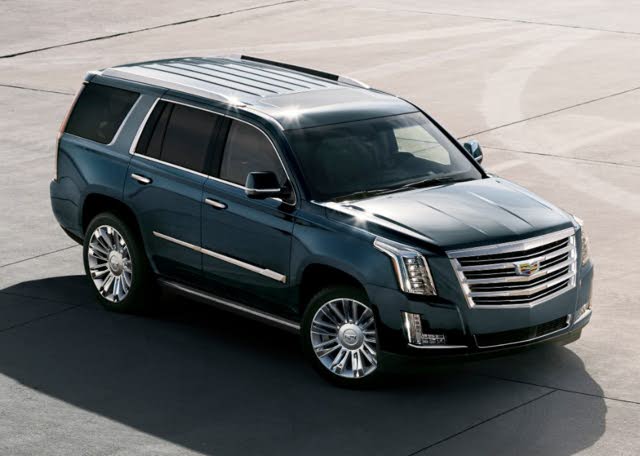2021 Honda CR-V vs 2020 Cadillac Escalade
Overview | |
MSRP$75,195 | MSRP$25,350 |
Listings18 | Listings408 |
Ratings & Reviews | |
User Reviews | User Reviews |
Expert reviews | Expert reviews7.8 out of 10 |
2020 Cadillac Escalade Reviews Summary | |
2021 Honda CR-V Reviews SummaryEven in a grim year, Honda is selling a staggering number of CR-Vs. The CR-V is the best-selling Honda in Canada, edging out the home-built Honda Civic. The CR-V is also the second best-selling compact SUV, just behind the Toyota RAV4. And it was the sixth best-selling vehicle in Canada in 2021. So, it’s hard to argue against the CR-V formula. Honda’s been at this almost as long as crossovers have been a thing, launching the CR-V in 1997—a year after the RAV4 debuted. The funny thing is, aside from sales volume, there’s only one thing the CR-V particularly excels at. Aesthetics are subjective, but it would be hard to argue the CR-V is the best-looking vehicle in its class. It’s not the cheapest. It’s not the best equipped, especially at the middle to lower trim levels. It’s not the fastest, nor is it the quietest, or the most fuel efficient. It’s not even the most reliable, showing up nowhere in J.D. Power's Most Reliable list. So, what makes it so appealing to Canadian consumers? Let’s see if we can figure that out. | |
No video found | No video found |
Popular Features & Specs | |
Engine6.2L 420 hp V8 | Engine1.5L 190 hp I4 |
Drive TrainRWD | Drive TrainFWD |
Seating Capacity8 | Seating Capacity5 |
Horsepower420 hp @ 5600 rpm | Horsepower190 hp @ 5600 rpm |
MPG City14 | MPG City28 |
MPG Highway23 | MPG Highway34 |
Engine | |
Engine Name6.2L 420 hp V8 | Engine Name1.5L 190 hp I4 |
Torque460 lb-ft @ 4100 rpm | Torque179 lb-ft @ 2000 rpm |
Horsepower420 hp @ 5600 rpm | Horsepower190 hp @ 5600 rpm |
DrivetrainRWD | DrivetrainFWD |
Fuel Economy | |
MPG City14 | MPG City28 |
MPG Highway23 | MPG Highway34 |
Interior | |
Seating Capacity8 | Seating Capacity5 |
Key Features | |
Navigation SystemStandard | Navigation System |
Safety | |
Front Crash Overall | Front Crash Overall5 |
Side Crash Overall5 | Side Crash Overall5 |
Dimensions & Capacity | |
Cargo Space15.2 cu ft | Cargo Space39.2 cu ft |
Curb Weight5578 lbs | Curb Weight3337 lbs |
Height74.4 in | Height66.1 in |
Length203.9 in | Length182.1 in |
Width80.5 in | Width73.0 in |
Wheelbase116.0 in | Wheelbase104.8 in |
Maximum Payload1460 lbs | Maximum Payload1358 lbs |
Number of doors4 | Number of doors4 |
Maximum Towing Capacity8300 lbs | Maximum Towing Capacity1500 lbs |
Standard Towing Capacity8300 lbs | Standard Towing Capacity |
Overview | ||
MSRP | $75,195 | $25,350 |
Listings | ||
Ratings & Reviews | ||
User reviews | ||
Expert reviews | 7.8 out of 10Read full review | |
Pros & cons | ||
Summary | Even in a grim year, Honda is selling a staggering number of CR-Vs. The CR-V is the best-selling Honda in Canada, edging out the home-built Honda Civic. The CR-V is also the second best-selling compact SUV, just behind the Toyota RAV4. And it was the sixth best-selling vehicle in Canada in 2021. So, it’s hard to argue against the CR-V formula. Honda’s been at this almost as long as crossovers have been a thing, launching the CR-V in 1997—a year after the RAV4 debuted. The funny thing is, aside from sales volume, there’s only one thing the CR-V particularly excels at. Aesthetics are subjective, but it would be hard to argue the CR-V is the best-looking vehicle in its class. It’s not the cheapest. It’s not the best equipped, especially at the middle to lower trim levels. It’s not the fastest, nor is it the quietest, or the most fuel efficient. It’s not even the most reliable, showing up nowhere in J.D. Power's Most Reliable list. So, what makes it so appealing to Canadian consumers? Let’s see if we can figure that out. | |
Video | No video found | No video found |
Popular Features & Specs | ||
Engine | 6.2L 420 hp V8 | 1.5L 190 hp I4 |
Drive Train | RWD | FWD |
Seating Capacity | 8 | 5 |
Horsepower | 420 hp @ 5600 rpm | 190 hp @ 5600 rpm |
MPG City | 14 | 28 |
MPG Highway | 23 | 34 |
Engine | ||
Engine Name | 6.2L 420 hp V8 | 1.5L 190 hp I4 |
Torque | 460 lb-ft @ 4100 rpm | 179 lb-ft @ 2000 rpm |
Horsepower | 420 hp @ 5600 rpm | 190 hp @ 5600 rpm |
Drivetrain | RWD | FWD |
Fuel Economy | ||
MPG City | 14 | 28 |
MPG Highway | 23 | 34 |
Interior | ||
Seating Capacity | 8 | 5 |
Key Features | ||
Navigation System | Standard | |
Safety | ||
Front Crash Overall | 5 | |
Side Crash Overall | 5 | 5 |
Dimensions & Capacity | ||
Cargo Space | 15.2 cu ft | 39.2 cu ft |
Curb Weight | 5578 lbs | 3337 lbs |
Height | 74.4 in | 66.1 in |
Length | 203.9 in | 182.1 in |
Width | 80.5 in | 73.0 in |
Wheelbase | 116.0 in | 104.8 in |
Maximum Payload | 1460 lbs | 1358 lbs |
Number of doors | 4 | 4 |
Maximum Towing Capacity | 8300 lbs | 1500 lbs |
Standard Towing Capacity | 8300 lbs | |

By: CarGurus + AI
At CarGurus, our team of experienced automotive writers remain at the heart of our content operation, conducting hands-on car tests and writing insightful guides that are backed by years of industry experience. To complement this, we are harnessing AI to make our content offering more diverse and more helpful to shoppers than ever. To achieve this, our AI systems are based exclusively on CarGurus content, ratings and data, so that what we produce is both unique to CarGurus, and uniquely helpful to car shoppers.






































